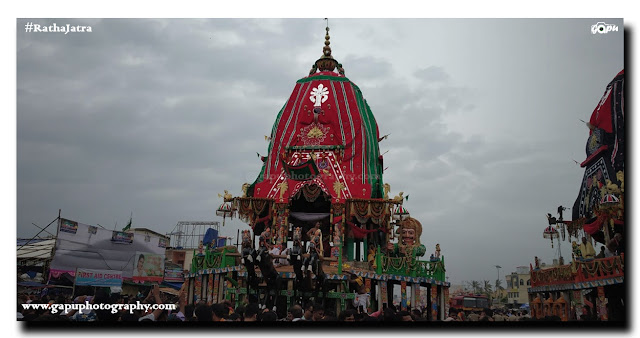Ratha Jatra (Odia: ରଥଯାତ୍ରା) is one of the most ancient and grandest Hindu festivals in the world. It is celebrated every year in the month of Ashadha (June-July) in Puri, Odisha, India. It marks the annual journey of Lord Jagannath, the supreme lord of the universe, and his brother Balabhadra and sister Subhadra, from their main temple, Srimandira to their aunt’s temple, Gundicha Temple.
The History of Ratha Jatra
Ratha Jatra has its origins in the legends and myths associated with Lord Jagannath, who is believed to be an incarnation of Lord Vishnu. According to one legend, King Indradyumna of Puri wanted to worship Lord Vishnu in his best form. He was advised by a sage to find a log of wood floating in the sea and carve idols out of it. The king sent his men to look for the log, but they could not find it. Then, a divine voice told the king that the log was at the seashore. The king went there and found a huge log with a peculiar fragrance. He brought it to his palace and invited many sculptors to carve idols out of it. But none of them could even touch the log.
Then, an old man appeared and claimed that he could carve the idols. He asked the king to give him 21 days and a closed chamber to work. The king agreed and provided him with all the facilities. But after 14 days, queen Gundicha became impatient and curious. She could not hear any sound from the chamber and thought that the old man had died. They broke open the door and entered the chamber. To their surprise, they saw three incomplete idols of Lord Jagannath, Balabhadra, and Subhadra, without hands and feet. The old man was nowhere to be seen.
The king realized that the old man was none other than Lord Vishnu himself, who had come to carve his own idols. He felt guilty for disturbing him and prayed for forgiveness. Then, a divine voice told him that this was the will of Lord Jagannath, who wanted to manifest himself in this form, which is beyond the human conception of beauty and perfection. The voice also told him to install the idols in a temple and worship them with love and devotion.
The king followed the instructions and built a magnificent temple for Lord Jagannath and his siblings. He also arranged for a grand festival every year, when the deities would be taken out of the temple in chariots to visit their aunt’s temple, Gundicha Temple, which was about 3 km away. This festival came to be known as Ratha Yatra or Chariot Festival.
The Rituals of Ratha Jatra
Ratha Jatra begins on the second day of the bright fortnight of Ashadha month. On this day, the deities are taken out of their sanctum in a ceremonial procession called Pahandi Bije. They are carried by their servitors on their shoulders amid chants and music to their respective Raths (chariots) parked outside the temple. The chariots are huge wooden structures decorated with colorful fabrics and flags. They are named Nandighosha for Lord Jagannath, Taladhwaja for Balabhadra, and Darpadalana for Subhadra.
The next ritual is Chhera Pahanra. This is performed by the Gajapati Maharaja, the king of Puri, who is the first servitor of Lord Jagannath. The king sweeps the platforms of the chariots with a golden broom and sprinkles sandalwood water and flowers on them. This signifies that even the highest authority is a humble servant of the Lord.
The final ritual is the pulling of the chariots by thousands of devotees who throng the Bada Danda (Grand Road) to participate in this sacred act. The chariots are pulled with ropes amid chants of “Jai Jagannath” (Hail Lord Jagannath) and “Hari Bol” (Praise the Lord).
The deities arrive at Gundicha Temple after some hours and are greeted by their aunt with warmth and affection. They stay there for a week and relish various dishes made by her. They also do various rites and ceremonies at Gundicha Temple.
Bahuda Jatra
On the ninth day, they return to Srimandira in a similar manner. This is called Bahuda Jatra (return journey). On their way back, they stop at the Mausima Temple (aunt’s temple), where they are offered Poda Pitha. They also adorn themselves with gold ornaments on their chariots on this day. This is called Suna Besha (golden attire).
The deities enter their main temple with a ritual called Niladri Bije (homecoming). They are greeted by their consort Goddess Lakshmi, who awaits them at the temple. The festival ends with a reunion of the divine couple.
Maa Laxmi was upset with the lord, so, she closes the entry gate. After that, Lord Jagannath offers Rasagola to Lakshmi Mata and enters into Srimandira to sit on Ratna Bedi.
The Significance of Ratha Jatra
Ratha Jatra is not just a physical journey of the deities, but also a spiritual journey of the devotees. It symbolizes the bond of love and devotion between Lord Jagannath and his devotees, who consider him as their friend, brother, father, master, and lover. It also represents the human quest for the divine, as the devotees follow the Lord wherever he goes.
Rath Yatra also has some special features that make it unique and interesting. One of them is that the deities are made of wood and are replaced every 12 or 19 years in a secret ceremony called Nabakalebara. This signifies the concept of reincarnation and renewal in Hinduism.
Another feature is that the deities have no arms and feet, and are painted with bright colors. This signifies that they are beyond the human conception of form and beauty and that they can be approached by anyone irrespective of caste, creed, or status.
Ratha Jatra is a festival that celebrates the universal love and compassion of Lord Jagannath, who comes out of his temple to bless his devotees. It is a festival that showcases the rich culture and heritage of Odisha, and its spirit of harmony and brotherhood. It is a festival that fills everyone’s heart with joy and peace.













0 Comments